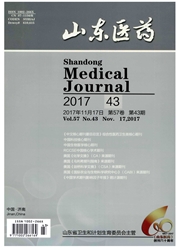

 中文摘要:
中文摘要:
[目的]从类泛素化(SUMO)角度研究丹参对缺血性脑血管病后的神经元保护机制。[方法]原代分离培养SD大鼠海马神经元细胞,免疫荧光方法予以鉴定;制作神经元体外氧糖剥夺(OGD)模型,分为对照组、OGD组和丹参治疗组;酶联免疫吸附(ELISA)法检测乳酸脱氢酶(LDH)含量,原位凋亡法检测凋亡细胞率;蛋白印记和免疫荧光方法检测SUMO—1和SUMO-2/3在细胞内的表达定量和定位情况。[结果]所培养细胞高表达神经元特异性烯醇化酶(NSE)和微管相关蛋白-2(MAP-2),胶质纤维酸性蛋白(GFAP),神经元纯度大于95%;ELISA结果显示,3组中LDH含量对照组〈丹参治疗组〈OGD组;凋亡细胞率对照组〈丹参治疗组〈OGD组;蛋白印记结果显示,神经元接受OGD处理后SUMO-2/3的蛋白表达量明显上升(P〈0.05),但SUMO-1无明显变化(P〉0.05),而丹参治疗能够进一步提高SUMO-2/3的表达(P〈0.05);免疫荧光结果湿示OGD神经元发生了SUMO-2/3南细胞浆向细胞核的明显移位现象,而丹参治疗能够进一步增强这种效果。[结论]丹参能够通过诱导SUMO-2/3,而非SUMO-1的活化机制,发挥对缺血神经元的保护作用。
 英文摘要:
英文摘要:
[Objective] To study the protection mechanism of salvia miltiorrhiza on neurons after ischemic cerebral vascular disease from the field of small ubiquitin-like protein (SUMOs). [Methods] The neurons were cultured from the hippocampal of SD rats, and identified by fluorescence immunoassay method. After making oxygen glucose deprivation (OGD) model for neurons, we designed three groups for this study: control group, OGD group and salvia miltionhiza group. The lactate dehydrogenase (LDH) content was detected by ELISA, and apoptosis by apoptosis in situ. Then the quantitative expression and intracellular localization of SUMO-land SUMO-2/3 proteins were detected by western blot and immunofluorescence method. [Results] The cultured cells were with high expression of neuron specific enolase (NSE) and microtubule associated protein-2 (MAP-2), but low level of glial fibrillary acidic protein (GFAP), the neuron purity greater than 95%. ELISA results showed that the content of LDH in the three groups were control group 〈 Salvia miltiorrhiza group 〈OGD group, as well as the results from apoptosis. Western blotting results showed that the level of SUMO-2/3 of neurons received OGD treatment was raised significantly (P〈0.05), but there was no significant change in SUMO-1 (P〉0.05), and salvia miltiorrhiza treatment can further improve the expression of SUMO-2/3 (P〈0.05). Immunohistochemistry results showed that there was apparent shift of SUMO-2/3 from cytoplasm to nucleus in OGD neurons, and salvia mihiorrhiza treatment could further enhance this effect. [Conclusion] Salvia mihiorrhiza can induce SUMO-2/3 activation and enhance protect effects on ischemic neurons.
 同期刊论文项目
同期刊论文项目
 同项目期刊论文
同项目期刊论文
 期刊信息
期刊信息
